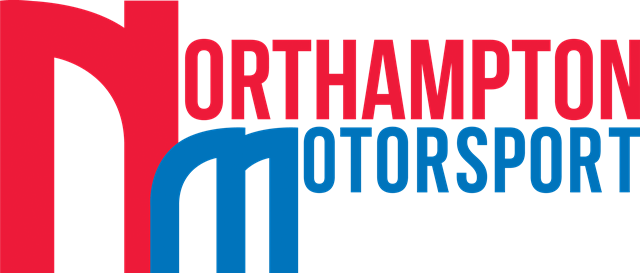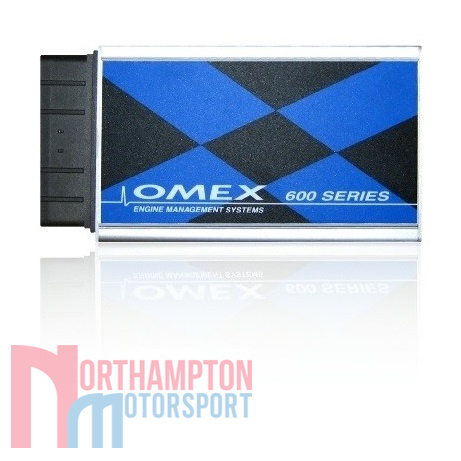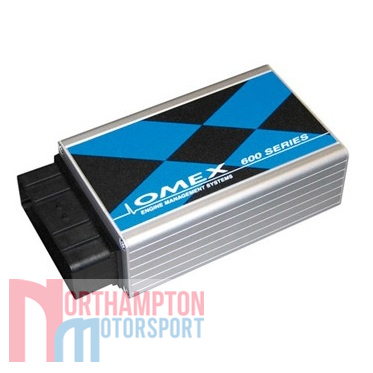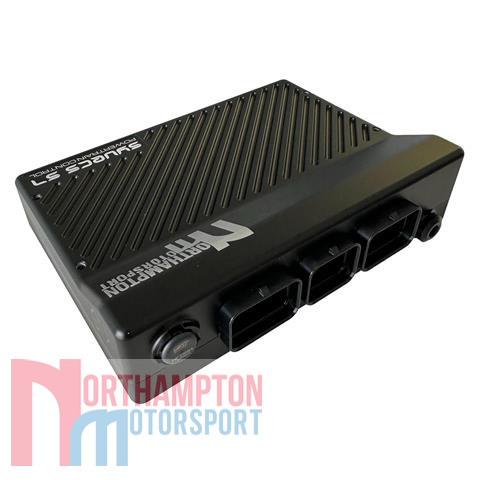Description
The Omex 600 Engine Management System is a high performance, easy to install, easy to map system with all of the features now demanded in motorsport.
This Engine Management System (ECU) is a Semi-sequential, single or dual coil ignition fuel injection for up to 4 cylinder engines.
Omex 600 ECU Specification:
Features
- Semi-sequential fuel injection for up to 4 cylinder engines
- Distributorless or distributor ignition for up to 4 cylinders
- Programmable load and speed sites
- TPS or MAP can be used for main load sensing
- Wide range of crank trigger patterns are suitable (user programmable)
- Turbo wastegate control
- Turbo anti-lag system
- Variable cam control
- Launch control
- Narrow and wide band lambda support
- Push/pull, and single line idle controls in addition to scattered spark control
- Knock sensing capability
- 3 programmable outputs switched on user controlled inputs (eg boost, coolant temp etc)
- Security protected calibrations
- Full throttle gearchange
- Intercooler water spray control
- Water injection control
- Nitrous ignition retard and fuel enrichment
- Two cooling fan controls
- Barometric compensation with external sensor
- Uses the latest version of the superb MAP3000 Windows programming software
- Suitable for normally aspirated or boosted engines
- Inbuilt independent fuel and ignition rev limiters
- Separate Tachometer, Shift Light and Fuel Pump outputs
- Magnetic or Hall Effect crank sensors
- Automatic interpolation between mapped sites
- Sophisticated acceleration fuelling setup
- Various harness options from economical semi-assembled to full race quality bespoke looms
- Battery voltage compensation table for fuel injectors (not just a simple number)
- Battery compensation and engine speed compensation for coil charge time
- Mappable coolant temperature compensation for engine warm-up
- Air & coolant temperature compensation for fuel injection pulse width
- Separate cold cranking and decay tables in addition to warm-up fuelling
- User settable ignition trim based on air temperature, coolant temperature, and barometric pressure
- Separate start advance for cranking provides easy starting for high compression engines
- Deceleration fuel cut-off feature for road engines
- Maximum recommended engine speed 12,750 RPM
And lots, lots more!
Inputs
Engine Speed and position is read from a pattern of teeth on the crank. Most manufacturers patterns are already known such as Ford 36-1, Bosch 60-2, Rover (18-1 twice and late K series), Toyota 36-2 etc If using an engine without a crank trigger pattern, an external trigger wheel can be fitted. The trigger wheel is a general-purpose part and will require machining to fit the crank pulley with the crank position sensor mounted facing it.
The ECU needs an input of engine load. The Omex ECU can use an input of throttle position or manifold absolute pressure (MAP). Most normally aspirated engines will use an input of throttle position as this gives excellent throttle response. Forced induction engines need to use MAP as there is no direct relationship between throttle angle and engine load due to the variable of boost pressure. However, forced induction still requires throttle position sensor (TPS) input for idle condition and acceleration fuelling information.
If using the engine’s original inlet system, the OE sensor can normally be used. Omex stocks a variety of different throttle position sensors to suit different applications if not using the OE inlet.
The ECU needs an input of engine load. The Omex 600 ECU can use an input of throttle position or manifold absolute pressure (MAP). Most normally aspirated engines will use an input of throttle position as this gives excellent throttle response. Forced induction engines need to use MAP as there is no direct relationship between throttle angle and engine load due to the variable of boost pressure. However, forced induction still requires throttle position sensor (TPS) input for idle condition and acceleration fuelling information. It is possible to also use TPS as the main load sensor with a boost compensation from the MAP sensor. The rating of MAP sensors is absolute, not boost pressure. Therefore a 2bar sensor is for up to 1bar boost and a 3bar for up to 2bar boost.
The coolant temperature sensor is used to give user definable cold running fuel correction based on coolant temperature. A user definable ignition retard based on coolant temperature is also possible. The input from the coolant temperature sensor can be user calibrated in the ECU software allowing nearly all standard sensors to be used. Omex can supply a sensor with a known calibration if required.
The air temperature sensor is used to give user definable fuel correction and ignition retard based on inlet air temperature. The input from the air temperature sensor can be user calibrated in the ECU software allowing nearly all standard sensors to be used. Omex can supply a sensor with a known calibration if required.
The ECU can use an input of narrowband or wideband (with external adaptor) lambda to make constant trims to the fuelling for best emissions and fuel economy without affecting ultimate power.
Most modern vehicles are fitted with a lambda sensor as standard. If one needs to be fitted to an engine that does not have the mounting boss in the exhaust, Omex can supply a mild steel boss to be welded into the exhaust.
A dedicated knock sensor input allows sensing of knock and user definable ignition and fuelling trims based on the knock input. An output could also be set to indicate knock to the driver whilst running the engine. Many newer engines have sensors as standard, whilst older engines can have the sensor fitted. This sensor is not required for engine running, it is an optional safety feature.
Full Throttle Gearshift allows the gear to be changed without releasing the throttle, reducing the time taken for the shift, and in turbo applications reducing the slow down of the turbo speed. A clutch switch or gear lever switch must be fitted to indicate that the gear change is occurring, at which point the ECU can retard the ignition in a user definable manner to reduce engine torque and allow the shift.
The ECU has three auxiliary inputs that can be used to switch functions such as Anti-lag, Full Throttle Gearshift etc. or provide variable modifiers to functions such as the Traction Control.
Outputs:
The Omex 600 series ECU has two injector outputs that are used to control 4 injectors semi-sequentially. Injectors should be high impedance, but low impedance injectors can be used with ballast resistors. Here at Northampton Motorsport, we can supply injectors in a range of flowrates and length which can be found in our “Engine Externals” area of the website.
The Omex ECU has 2 coil outputs allowing either ‘single coil with distributor’ or 4cyl distributorless (DIS wasted spark) ignition.
The Omex 600 ECU can control idle by scatter spark, or if the engine is fitted with an idle air bypass motor, has 4 dedicated idle control wires to allow use of single wire or twin wire idle controls.
- Turbo Anti Lag: As found on WRC rally cars, turbo anti-lag keeps the boost pressure high and the turbocharger spinning by keeping the gas flow high, but maintains drivability by controlling the torque. The gas flow can be achieved by jacking open the throttle with a solenoid, air bypass valves, or if a low level of anti-lag is used, often by opening the idle motor fully. To control torque, the ECU retards the ignition.
- Boost Control: Boost pressure is regulated by the turbo wastegate which is opened at a boost pressure set by the actuator. To increase boost pressure at which the the wastegate is opened, the actuator needs to see a lower pressure than actually exists in the inlet manifold. The ECU can control a solenoid or air injector to do this. The solenoid or air injector can be turned off / on to give low (actuator level) and high (ECU controlled) boost.
VTEC single switch point cam control with user definable engine load, throttle position, and engine speed switch point and user definable hysteresis levels to aid smooth transitions from one cam profile to the next. Ignition and fuel trims are also possible in the VTEC mode.
A button activated launch control mode allows the driver to hold the engine with a user definable, temporary lower rev limit with ignition retards, ignition cuts, or a combination of both.
Turbocharged engines gain from increased launch boost with decreased launch engine speed; same power, lower engine speed. The further the throttle is pressed, the greater the boost, but with no increase in engine speed.
2 radiator fan outputs allow 2 speed or staged fan control.
A shift light output allows an LED or bulb to be set to light at a user definable engine speed to indicate the optimum gearshift point. Omex can supply a 5mm or 10mm ultrabright LED with mounting bezel.
A shift light output allows an LED or bulb to be set to light at a user definable engine speed to indicate the optimum gearshift point. Omex can supply a 5mm or 10mm ultrabright LED with mounting bezel.
Fuel pump controls can control a fuel pump relay to prime the pump at ignition ON and then run the pump when the engine is being run.
The 600 series ECU can have any of its parameters (inputs, outputs, and all the calculations in between) recorded whilst connected live to a PC. The results of this logging can be viewed using the analysis tool DATA2000
Auxiliary Outputs for both pulsewidth and switch controls allow the user to choose from up to 4 auxiliary functions such as a second cooling fan, wastegate control, VTEC control etc.
Here at Northampton Motorsport, we also offer a full wiring and fitting service as well as engine calibration on our in house Superflow AD30 2 wheel drive chassis dyno. For more information, please contact us and a member of our team would be happy to assist with your enquiry:
Estimated dispatch time within 3 working days.
Picture for illustration purposes only. Actual parts may differ slightly in appearance.








